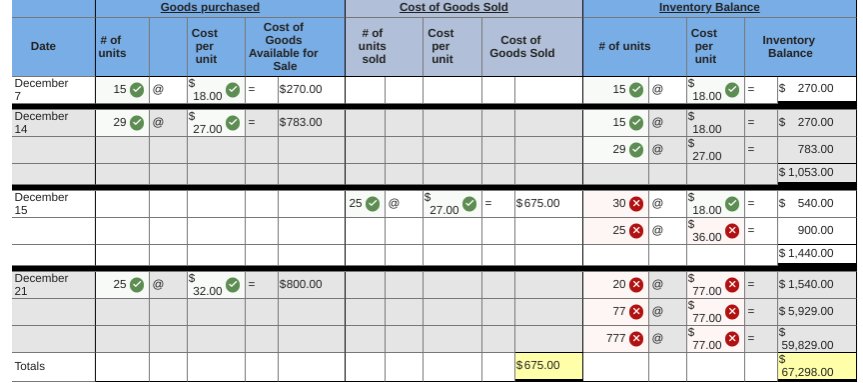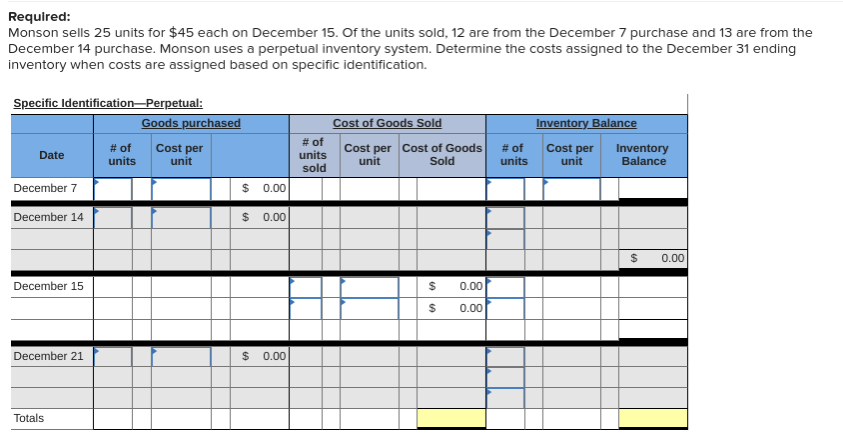Question
1) Required information Use the following information for the Quick Study below. Trey Monson starts a merchandising business on December 1 and enters into the
1) Required information
Use the following information for the Quick Study below.
Trey Monson starts a merchandising business on December 1 and enters into the following three inventory purchases. Also, on December 15, Monson sells 25 units for $45 each.
| Purchases on December 7 | 15 units @ $18.00 cost |
| Purchases on December 14 | 29 units @ $27.00 cost |
| Purchases on December 21 | 25 units @ $32.00 cost |
QS 5-11 Perpetual: Inventory costing with LIFO LO P1
Required: Monson sells 25 units for $45 each on December 15. Monson uses a perpetual inventory system. Determine the costs assigned to the December 31 ending inventory when costs are assigned based on LIFO.
 2) Purchase March 1 = 100 units @ $50 each March 5 = 400 unites @ $55 each March 18 = 120 unites @ $60 each March 25 = 200 unites @ $ 62 each Sales March 9 = 420 unites @ $ 85 each March 29 = 160 unites @ $95 each
2) Purchase March 1 = 100 units @ $50 each March 5 = 400 unites @ $55 each March 18 = 120 unites @ $60 each March 25 = 200 unites @ $ 62 each Sales March 9 = 420 unites @ $ 85 each March 29 = 160 unites @ $95 each
1(a). Compute the number of units available for sale in March. 1(b). Compute the number of units in ending inventory on March 31. 2. Compute the cost assigned to ending inventory using specific identification. Note: The March 9 sale consists of 80 units from March 1 purchase and 340 units from the March 5 purchase; the March 29 sale consists of 40 units from the March 18 purchase and 120 units from the March 25 purchase. 


3 ) Required information
Use the following information for the Quick Study below.
Trey Monson starts a merchandising business on December 1 and enters into the following three inventory purchases. Also, on December 15, Monson sells 25 units for $45 each.
| Purchases on December 7 | 15 units @ $18.00 cost |
| Purchases on December 14 | 29 units @ $27.00 cost |
| Purchases on December 21 | 25 units @ $32.00 cost |
QS 5-12 Perpetual: Inventory costing with weighted average LO P1
Required: Monson sells 25 units for $45 each on December 15. Monson uses a perpetual inventory system. Determine the costs assigned to ending inventory when costs are assigned based on the weighted average method. (Round your per unit costs to 2 decimal places.) 
4) Use the following information for the Quick Study below.
Trey Monson starts a merchandising business on December 1 and enters into the following three inventory purchases. Also, on December 15, Monson sells 25 units for $45 each.
| Purchases on December 7 | 15 units @ $18.00 cost |
| Purchases on December 14 | 29 units @ $27.00 cost |
| Purchases on December 21 | 25 units @ $32.00 cost |
QS 5-13 Perpetual: Inventory costing with specific identification LO P1
Required: Monson sells 25 units for $45 each on December 15. Of the units sold, 12 are from the December 7 purchase and 13 are from the December 14 purchase. Monson uses a perpetual inventory system. Determine the costs assigned to the December 31 ending inventory when costs are assigned based on specific identification. 
Step by Step Solution
There are 3 Steps involved in it
Step: 1

Get Instant Access to Expert-Tailored Solutions
See step-by-step solutions with expert insights and AI powered tools for academic success
Step: 2

Step: 3

Ace Your Homework with AI
Get the answers you need in no time with our AI-driven, step-by-step assistance
Get Started


